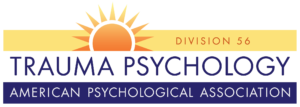Child & Adolescent Trauma Assessment and Treatment Tip Sheets
Assessment Tip Sheet
This Tip Sheet for psychologists and other mental health professionals who conduct clinical screening and assessment with children and adolescents was developed by the Division 56 Child Trauma Task Force. The Tip Sheet is designed to assist clinicians in making screening for trauma exposure and trauma symptoms a standard practice in their work with children and families. Guidelines are provided elucidating the basic requirements for doing child trauma screening and assessment that is efficient, comprehensive, evidence-based, sensitive to individual and cultural differences, and coordinated across all relevant services and providers for the child and family. Key principles for deciding when and how to make referrals for child trauma assessment also are provided for clinicians who do not specialize in child trauma assessment/treatment when trauma screening indicates a need for a specialized trauma assessment and potentially for child trauma treatment. The Tip Sheet also alerts psychologists to potential pitfalls in child trauma screening/assessment that can result in clinical problems, and suggests appropriate precautions to avoid those pitfalls.
Suggested citation: Ford, J. D., Stover, C. S., Elmore, D., Ghosh Ippen, C., Hanson, R. F., Kassam-Adams, N., Kerig, P. K., & Mannarino, A. P. (2017). Trauma Screening and Assessment for Children and Adolescents: Tips for Psychologists. Washington, DC: American Psychological Association Division 56 (Trauma Psychology). http://www.apatraumadivision.org/679/child-adolescent-tip-sheets.html
Treatment Tip Sheet
This Tip Sheet for psychologists and other mental health professionals who conduct clinical assessment and treatment with children and adolescents was developed by the Division 56 Child Trauma Task Force. The Tip Sheet is designed to assist clinicians in recognizing and providing empirically-supported best practices for the treatment of trauma-related symptoms and impairments as a standard practice in their work with children and families. Guidelines are provided for treatment that is efficient, comprehensive, evidence-based, sensitive to individual and cultural differences, and coordinated across all relevant services and providers for the child and family. Key principles for deciding when and how to make referrals for child trauma treatment are provided for clinicians who do not specialize in child trauma assessment/treatment when screening or assessment indicates a need for specialized trauma treatment. The Tip Sheet alerts psychologists to potential pitfalls in child trauma treatment that can result in clinical problems, and suggests appropriate precautions to avoid those pitfalls.
Suggested citation: Ford, J. D., Stover, C. S., Elmore, D., Ghosh Ippen, C., Hanson, R. F., Kassam-Adams, N., Kerig, P. K., & Mannarino, A. P. (2017). Treatment of Children and Adolescents with Trauma Symptoms: Tips for Psychologists. Washington, DC: American Psychological Association Division 56 (Trauma psychology). http://www.apatraumadivision.org/679/child-adolescent-tip-sheets.html
